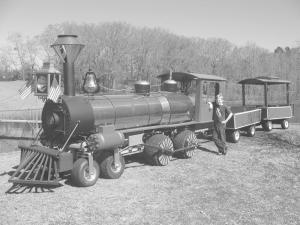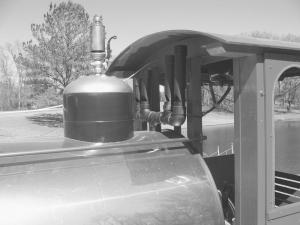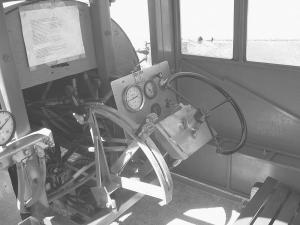2007 - Volume #31, Issue #3, Page #23
[ Sample Stories From This Issue | List of All Stories In This Issue | Print this story
| Read this issue]
Rubber-Tired Locomotive Great Fun For Kids
 |
 |
 |
The locomotive is painted red, silver and black and is complete with a cow catcher on front, as well as an antique bronze bell off an old fire wagon, a big headlight, and a big stainless steel smoke stack. It pulls a 4-wheeled car and caboose that can hold up to twelve kids at a time.
"It's always a hit at the birthday parties we host at our farm for grandkids and adults alike," says Rowell, who is a retired mechanical engineer.
The locomotive's running gear consists of two hydrostatic transmissions, rear axles and wheels - one set off each pecan sweeper - that are bolted together to provide 4-WD. There are four smaller caster wheels on front for steering. One of the sweeper engines, a V-4 Wisconsin, was rebuilt and is used to chain-drive a hydraulic pump that powers both transmissions. The transmissions are controlled by two levers that are tied together inside the cab, allowing Rowell to operate both transmissions with one hand. (Each lever goes to a separate hydrostatic axle.)
Steering to the four front wheels is powered by a hydraulic cylinder. The engine's exhaust pipe exits out the smoke stack on front of the locomotive.
An air compressor that's belt-driven off the engine supplies air for the locomotive's whistle. It's made out of four 1 1/2-in. dia. pvc pipes of different lengths to provide the right sound. Air from the compressor goes to a pair of air tanks located above the front wheels.
"I couldn't be happier with how it turned out," says Rowell. "We have five grandkids so we use it a lot. The two cars were built out of a pair of 4-wheel yard carts.
"Because of the hydrostatic transmissions it's real easy to operate, with no need for a clutch or brakes. I push the levers to go forward and pull them to go in reverse. The throttle is connected to a solenoid, so to accelerate I just flip a switch and the engine speeds up to the proper rpm's. Usually I go at a fast walking speed.
"The bell was the most difficult component to find and is also the most expensive single item on my locomotive. I bought it from Brosamer's Bells in Michigan at a price of $475. However, it was worth it because it's a genuine bronze bell with a real sound."
Rowell used to work in the aircraft industry, so he made the locomotive's boiler much like the body of an airplane. It has a round rib frame made out of plywood that's covered with sheet metal.
The two decorative domes on top of the boiler are freon bottles turned upside down. One dome is for steam and the other for sand. "In the old days when the railroad tracks got icy, they would use the dome to dump sand in front of the drive wheels to improve traction," says Rowell.
The exhaust stack was made from a 6-in. dia length of pvc pipe, with the top formed from sheet metal and plywood. "I made the headlight out of wood and added a stainless steel reflector. I used 1/8 sq. steel tubing to make the cow catcher," he notes.
Contact: FARM SHOW Followup, Jerry Rowell, 681 Housers Mill Rd., Fort Valley, Ga. 31030 (ph 478 825-0412; geraldrowell@bellsouth.net).

Click here to download page story appeared in.

Click here to read entire issue
To read the rest of this story, download this issue below or click here to register with your account number.




